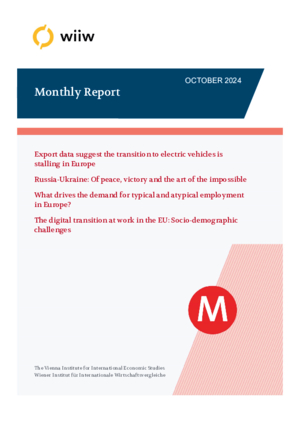Monthly Report No. 10/2024
Sebastian Leitner, Sandra M. Leitner, Alireza Sabouniha, Sergey Utkin, Zuzana Zavarská and Stella Sophie Zilian
wiiw Monthly Report No. 10, October 2024
57 pages including 28 Figures
- Chart of the month: Export data suggest the transition to electric vehicles is stalling in Europe
by Zuzana Zavarská
- Russia-Ukraine: Of peace, victory and the art of the impossible
by Sergey Utkin
Ukraine and Russia remain stuck in a zero-sum logic on all major issues, with diametrically opposed goals when it comes to Ukraine’s NATO membership, its military infrastructure and the outcome of the war. Nevertheless, were Trump to win the election, the new US president would probably force Ukraine to negotiate. The West’s lukewarm reception of Zelensky’s ‘victory plan’, presented in October 2024, may assist the Ukrainian leadership in shifting the blame for any potentially painful concessions onto its partners, who are unable to provide the support requested.
- What drives the demand for typical and atypical employment in Europe?
by Sandra M. Leitner and Alireza Sabouniha
Atypical, non-standard forms of employment have become more widespread, particularly in many advanced economies. This is of concern because of the negative impact on ‘atypical’ workers. We find that off-shoring and communication technology (CT) have been important drivers in the expansion of atypical employment in Europe – in the case of off-shoring, this has mainly been the case in service industries. The strictness of employment protection legislation (EPL) has played an important moderating role, damping down some of the negative effects, particularly in relation to off-shoring.
- The digital transition at work in the EU: Socio-demographic challenges
by Sebastian Leitner and Stella Zilian
In this article we document patterns of age segregation in digital job tasks across the EU. We find clear generational differences, as younger workers are more likely to work in positions that require more frequent and more complex use of digital technology, whereas older workers are more likely to work in positions that require a lower level of digital skills or no digital skills at all. We further find evidence of a gender gap, with women exhibiting a lower probability than men of performing digital tasks. The gender gap is most pronounced among digital natives, and it decreases with age.
- Monthly and quarterly statistics for Central, East and Southeast Europe
Reference to wiiw databases: wiiw Annual Database, wiiw Monthly Database
Keywords: automotive exports, electric vehicles, Zelensky’s ‘victory plan’, NATO membership, ceasefire negotiations, atypical employment, employment protection, off-shoring, technological change, digital transition at work, age segregation, gender gap
Countries covered: Europe, European Union, Russia, Ukraine
Research Areas: Labour, Migration and Income Distribution, Sectoral studies
